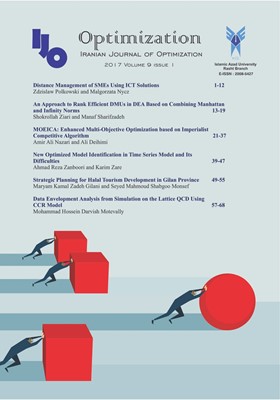An approach to rank efficient DMUs in DEA based on combining Manhattan and infinity norms
محورهای موضوعی : Data Envelopment Analysis
Shokrollah Ziari
1
![]() ,
Manaf Sharifzadeh
2
,
Manaf Sharifzadeh
2
1 - Department of Mathematics, Firoozkooh branch, Islamic Azad University, Firoozkooh,Iran
2 - Department of Computer, Firoozkooh branch, Islamic Azad University, Firoozkooh, Iran
کلید واژه: Data Envelopment Analysis (DEA), Ranking, Efficiency, Extreme efficient,
چکیده مقاله :
In many applications, discrimination among decision making units (DMUs) is a problematic technical task procedure to decision makers in data envelopment analysis (DEA). The DEA models unable to discriminate between extremely efficient DMUs. Hence, there is a growing interest in improving discrimination power in DEA yet. The aim of this paper is ranking extreme efficient DMUs in DEA based on exploiting the leave-one out idea and combining of Manhattan and infinity norms with constant and variable returns to scale. The proposed method has been able to overcome the existing difficulties in some ranking methods.
In many applications, discrimination among decision making units (DMUs) is a problematic technical task procedure to decision makers in data envelopment analysis (DEA). The DEA models unable to discriminate between extremely efficient DMUs. Hence, there is a growing interest in improving discrimination power in DEA yet. The aim of this paper is ranking extreme efficient DMUs in DEA based on exploiting the leave-one out idea and combining of Manhattan and infinity norms with constant and variable returns to scale. The proposed method has been able to overcome the existing difficulties in some ranking methods.
Amirteimoori, A., Jahanshahloo, G., & Kordrostami, S. (2005). Ranking of decision making units in data envelopment analysis: A distance-based approach. Applied mathematics and computation, 171(1), 122-135.
Andersen, P., & Petersen, N. C. (1993). A procedure for ranking efficient units in data envelopment analysis. Management science, 39(10), 1261-1264.
Bal, H., Örkcü, H. H., & Çelebioğlu, S. (2008). A new method based on the dispersion of weights in data envelopment analysis. Computers & Industrial Engineering, 54(3), 502-512.
Balf, F. R., Rezai, H. Z., Jahanshahloo, G. R., & Lotfi, F. H. (2012). Ranking efficient DMUs using the Tchebycheff norm. Applied Mathematical Modelling, 36(1), 46-56.
Banker, R. D., Charnes, A., & Cooper, W. W. (1984). Some models for estimating technical and scale inefficiencies in data envelopment analysis. Management science, 30(9), 1078-1092.
Charnes, A., Cooper, W. W., & Li, S. (1989). Using data envelopment analysis to evaluate efficiency in the economic performance of Chinese cities. Socio-Economic Planning Sciences, 23(6), 325-344.
Charnes, A., Cooper, W. W., & Rhodes, E. (1978). Measuring the efficiency of decision making units. European journal of operational research, 2(6), 429-444.
Hashimoto, A. (1997)1999. A ranked voting system using a DEA/AR exclusion model: A note. European Journal of Operational Research, 97(3), 600-604.
Jahanshahloo, G. R., & Shahmirzadi, P. F. (2013). New methods for ranking decision making units based on the dispersion of weights and Norm 1 in Data Envelopment Analysis. Computers & Industrial Engineering, 65(2), 187-193.
Jahanshahloo, G. R., Lotfi, F. H., Shoja, N., Tohidi, G., & Razavyan, S. (2004). Ranking using l 1-norm in data envelopment analysis. Applied mathematics and computation, 153(1), 215-224.
Jahanshahloo, G. R., Sanei, M., Lotfi, F. H., & Shoja, N. (2004). Using the gradient line for ranking DMUs in DEA. Applied mathematics and computation, 151(1), 209-219.
Khodabakhshi, M., & Aryavash, K. (2012). Ranking all units in data envelopment analysis. Applied Mathematics Letters, 25(12), 2066-2070.
Liu, F. H. F., & Peng, H. H. (2008). Ranking of units on the DEA frontier with common weights. Computers & Operations Research, 35(5), 1624-1637.
Mehrabian, S., Alirezaee, M. R., & Jahanshahloo, G. R. (1999). A complete efficiency ranking of decision making units in data envelopment analysis. Computational optimization and applications, 14(2), 261-266.
Ruiz, J. L., & Sirvent, I. (2016). Common benchmarking and ranking of units with DEA. Omega, 65, 1-9.
Seiford, L. M., & Zhu, J. (1999). Infeasibility of super-efficiency data envelopment analysis models. INFOR: Information Systems and Operational Research, 37(2), 174-187.
Sexton, T. R., Silkman, R. H., & Hogan, A. J. (1986). Data envelopment analysis: Critique and extensions. New Directions for Evaluation, 1986(32), 73-105.
Torgersen, A. M., Førsund, F. R., & Kittelsen, S . A. (1996). Slack-adjusted efficiency measures and ranking of efficient units. Journal of Productivity Analysis, 7(4), 379-398.
Wu, J., & Yan, H. (2010). An effective transformation in ranking using L 1-norm in data envelopment analysis. Applied Mathematics and Computation, 217(8), 4061-4064.
Zhu, J. (1998). Data envelopment analysis vs. principal component analysis: An illustrative study of economic performance of Chinese cities. European journal of operational research, 111(1), 50-61.
Ziari, M., & Ziari, S. (2016). Ranking efficient DMUs using the variation coefficient of weights in DEA. Iranian Journal of Optimization, 8(1), 897-907.
Ziari, S., & Raissi, S. (2016). Ranking efficient DMUs using minimizing distance in DEA. Journal of Industrial Engineering International, 12(2), 237-242.


